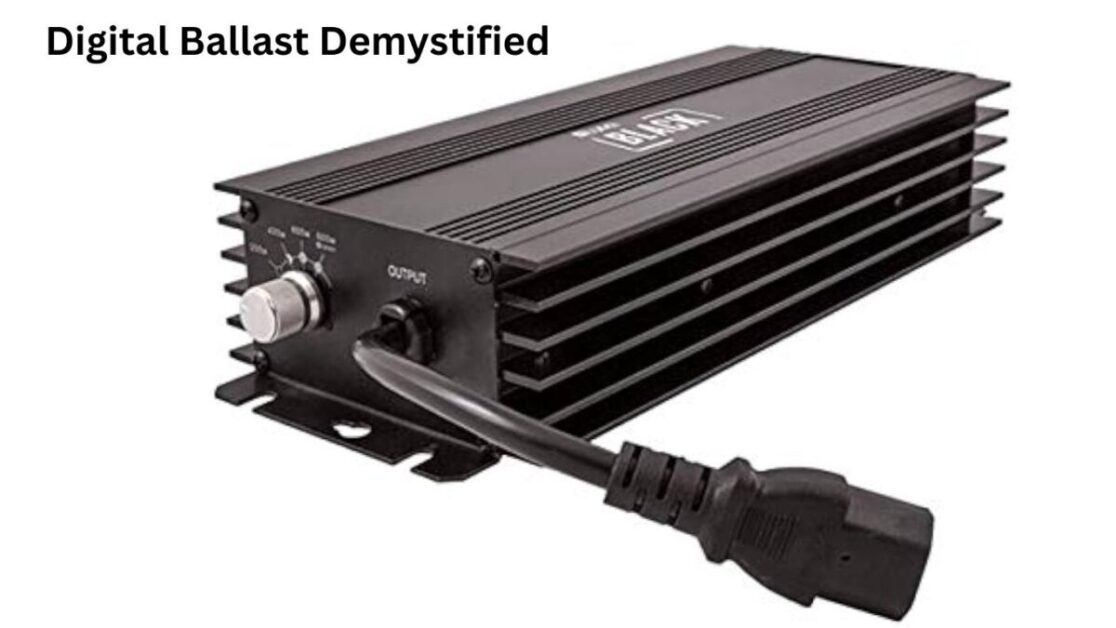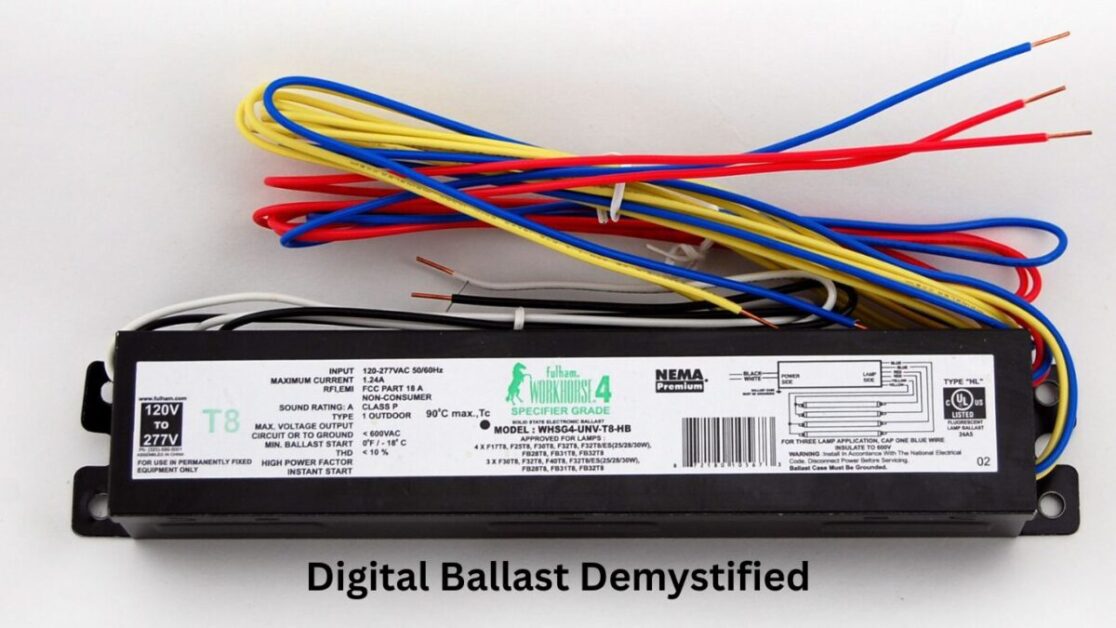A Digital Ballast Demystified: The Great HID Ballasts Guide
Table of Contents
What is a digital ballast?

A digital ballast is an electronic device used to regulate the electrical current that powers high-intensity discharge (HID) grow lights. Unlike traditional magnetic ballasts, digital ballasts utilize advanced technology to provide a more stable and efficient power supply to the lights. Digital ballasts are able to control the flow of electricity with precision, resulting in better performance and longer lifespan for the grow lights. These ballasts are essential components in indoor gardening setups, providing the necessary power and control for optimal plant growth and development.
Digital ballasts offer several advantages over traditional magnetic ballasts. One key benefit is their ability to operate at higher frequencies, which can lead to increased light output and improved energy efficiency. Additionally, digital ballasts are typically lighter and more compact than magnetic ballasts, making them easier to install and manage in grow rooms. The precise control of power delivery also allows for better customization of light intensity, spectrum, and duration, giving growers more flexibility in optimizing their plants’ growth conditions.
Different types of a digital ballasts
HID ballasts, or High-Intensity Discharge ballasts, are an essential component in controlling the electrical current that powers HID lamps. There are two main types of HID ballasts: magnetic ballasts and digital ballasts.
Magnetic ballasts have been traditionally used in HID lighting systems for many years. They operate on electromagnetic principles, which induce a current to start and regulate the lamp’s operation. While magnetic ballasts are cost-effective, they are known to produce a noticeable humming sound and can be less energy-efficient compared to digital ballasts. On the other hand, digital ballasts are a more modern and advanced option. They use microprocessors to control the flow of electricity to the lamp, resulting in increased efficiency, improved lamp performance, and reduced operating costs in the long run.
Advantages of using a digital ballast
Digital ballasts offer several advantages over traditional magnetic ballasts, making them an appealing choice for many indoor gardeners and horticultural enthusiasts. One key advantage is their ability to provide a more stable and consistent electrical current to the grow lights, resulting in improved efficiency and performance. This stable output can help optimize the growth and development of plants, leading to higher yields and better overall quality of produce.
In addition, digital ballasts are known for their energy efficiency, consuming less power compared to magnetic ballasts while still delivering the same level of light output. This can lead to reduced electricity costs over time and make them a more environmentally friendly option for those looking to minimize their carbon footprint. Moreover, digital ballasts produce less heat during operation, helping to maintain a more controlled and stable growing environment for plants.
Disadvantages of using a digital ballast
While digital ballasts offer numerous advantages, they also come with a few drawbacks. One significant disadvantage is that digital ballasts can be more expensive upfront compared to traditional magnetic ballasts. This initial higher cost might deter some growers from investing in digital ballasts, especially those on a tight budget. Additionally, digital ballasts are more sensitive to fluctuations in power and can be damaged if not properly protected or if the electrical supply is unstable.
Another disadvantage of using digital ballasts is their potential for electromagnetic interference (EMI). Due to the electronic components in digital ballasts, they can sometimes emit electromagnetic radiation that may interfere with other electronic devices in the vicinity. This can be a concern for growers who have sensitive equipment nearby or those operating in environments where EMI could be problematic. Achieving proper shielding and ensuring that digital ballasts meet regulatory standards can help mitigate this issue.
How does a digital ballast work?
A digital ballast works by converting an alternating current (AC) to direct current (DC) with the help of electronic components such as capacitors, resistors, and transistors. Unlike traditional magnetic ballasts, digital ballasts use microprocessors to regulate the electrical current, resulting in a more stable and efficient flow of power to the grow lights. This advanced technology allows digital ballasts to provide a consistent output of energy, which in turn leads to improved light quality and spectrum for optimal plant growth and development.
Additionally, digital ballasts feature built-in safety mechanisms, such as overheat protection and short-circuit detection, to prevent electrical failures and ensure the longevity of the ballast and connected lighting fixtures. By closely monitoring and controlling the electrical input and output, digital ballasts can tailor the power supply to suit different types of grow lights, making them a versatile and reliable choice for indoor gardening applications.
Factors to consider when choosing a digital ballast

When choosing a digital ballast for your hydroponic system, there are several key factors to consider to ensure optimal performance. One important factor is the wattage compatibility of the ballast with your grow lights. It is crucial to match the wattage of the ballast to the wattage requirements of your lights to prevent any damage to your equipment and ensure efficient operation. Additionally, consider the type of bulbs you will be using as digital ballasts are designed to work with specific types of bulbs such as metal halide or high-pressure sodium lamps.
Another factor to keep in mind is the efficiency rating of the digital ballast. Look for ballasts that are Energy Star certified or have high power factor ratings to ensure that you are maximizing energy efficiency and reducing electricity costs. Opting for a ballast with dimming capabilities can also provide flexibility in controlling light output and adjusting brightness levels based on the growth stage of your plants. Investing in a quality digital ballast that meets your specific requirements will ultimately contribute to the success of your indoor gardening endeavors.
Installation process for a digital ballast
To install a digital ballast for your indoor garden setup, begin by ensuring that the power to the grow lights is turned off and the circuit is safely disconnected. Next, mount the digital ballast in a secure location that allows for proper ventilation to prevent overheating. Connect the input power cord to a reliable power source, following the manufacturer’s guidelines for voltage and wiring instructions. Make sure all connections are tight and secure to prevent any electrical hazards. Once the ballast is securely installed, you can proceed with connecting the grow lights and any additional accessories according to the specific requirements of your setup.
After the physical installation is complete, it is important to double-check all connections to ensure they are correct and secure. Test the digital ballast by turning on the power and observing the functionality of the grow lights. If everything is working properly, you can proceed with adjusting the settings on the digital ballast to optimize the light intensity and photoperiod for your plants. Regularly monitor the performance of the digital ballast and grow lights to ensure they are functioning efficiently and effectively to support healthy plant growth in your indoor garden.
Troubleshooting common issues with a digital ballasts
A common issue that gardeners may encounter with digital ballasts is flickering lights. This could be caused by a faulty bulb, improper wiring, or an issue with the ballast itself. To troubleshoot this, first, try replacing the bulb with a new one to see if that resolves the flickering. If not, check the wiring connections to ensure they are secure and correct. If the issue persists, it may be necessary to replace the digital ballast.
Another issue that gardeners may face is overheating of the digital ballast. This can lead to malfunctions and reduced lifespan of the equipment. To address this problem, ensure that the ballast is placed in a well-ventilated area with sufficient airflow. Avoid overcrowding the ballast with other equipment or materials that could block the vents and cause overheating. If overheating continues to be a problem, consider investing in a cooling system or fan to help regulate the temperature of the digital ballast.
Comparison between digital ballasts and magnetic a digital ballasts
Digital ballasts and magnetic ballasts are two common options for powering HID grow lights, each with its own set of characteristics and advantages. One key difference between the two types of ballasts is their efficiency. Digital ballasts are known for their higher efficiency levels compared to magnetic ballasts, which can result in lower energy consumption and reduced operating costs over time. Additionally, digital ballasts tend to produce less heat during operation, creating a more favorable environment for plant growth in indoor settings.
On the other hand, magnetic ballasts are typically more affordable upfront compared to digital ballasts. However, they are heavier, bulkier, and less efficient in terms of energy consumption. Magnetic ballasts also tend to generate more heat, which can lead to issues with overheating and potentially impact the longevity of the grow lights. Overall, the choice between digital and magnetic ballasts will depend on various factors such as budget, energy efficiency goals, and the specific needs of your indoor gardening setup.
How to properly maintain a digital ballast
Regular maintenance of a digital ballast is essential to ensure optimal performance and prolong its lifespan. One key aspect of maintenance is keeping the ballast clean and free of dust and debris, as accumulation can lead to overheating and potential malfunctions. Regularly inspecting the ballast for any signs of wear or damage is also crucial, as addressing issues promptly can prevent more serious problems down the line. Additionally, checking the connections and ensuring they are secure is important to avoid any electrical issues.
Furthermore, it is recommended to follow the manufacturer’s guidelines for maintenance, including any specific instructions for cleaning or servicing the digital ballast. Keeping the ballast in a well-ventilated area and away from moisture can help prevent corrosion and other damage. Lastly, periodically testing the ballast with a compatible bulb to ensure it is functioning correctly is a good practice to identify any potential issues early on. By staying proactive with maintenance tasks, gardeners can maximize the efficiency and longevity of their digital ballasts.
Safety precautions when using a digital ballast
To ensure the safe and effective use of a digital ballast in your indoor gardening setup, there are several important safety precautions to keep in mind. Firstly, always make sure to read and follow the manufacturer’s instructions carefully when installing and using the digital ballast. This will help prevent any potential risks associated with improper handling or setup. Additionally, it is crucial to regularly inspect the digital ballast for any signs of damage or wear and tear. Faulty equipment can pose serious safety hazards, so maintaining the ballast in good condition is key to safe operation.
Furthermore, it is essential to handle the digital ballast with care, especially when dealing with electrical components. Always remember to unplug the ballast from the power source before attempting any maintenance or troubleshooting. Moreover, never attempt to repair or tamper with the internal components of the digital ballast unless you are a qualified professional. Electrical safety is paramount when working with any form of electronic equipment, so exercising caution and seeking expert help when needed is crucial.
Upgrading from a magnetic ballast to a digital ballast
When considering upgrading from a magnetic ballast to a digital ballast, it’s essential to understand the significant benefits that come with this transition. Digital ballasts offer improved efficiency, resulting in energy savings and reduced operating costs over time. Moreover, digital ballasts provide more precise control over light output, optimizing the growth conditions for plants and potentially leading to better yields.
The upgrade from a magnetic ballast to a digital one can also enhance the overall lifespan of the lighting system. With fewer components prone to failure, digital ballasts tend to be more durable and reliable in the long run, minimizing the need for frequent replacements and maintenance. This improved longevity not only saves time and effort but also contributes to a more sustainable and cost-effective gardening setup.
The future of digital ballasts in the industry
The future of digital ballasts in the industry looks promising, with advancements in technology continuously improving the performance and efficiency of these devices. As digital ballasts become more mainstream in the gardening and agriculture sectors, we can expect to see a shift towards greater energy savings, increased control over lighting conditions, and enhanced safety features. Manufacturers are investing in research and development to make digital ballasts more user-friendly, durable, and cost-effective, catering to the evolving needs of growers across different scales of operations.
Furthermore, the integration of digital ballasts with smart technologies and automation systems is poised to revolutionize how growers manage their indoor lighting setups. Imagine being able to adjust light intensity, spectrum, and duration remotely through a mobile app or automated system, optimizing plant growth and productivity with minimal manual intervention. With sustainability and resource efficiency becoming key priorities in the industry, digital ballasts offer a greener alternative to traditional lighting solutions, reducing energy consumption and environmental impact. Stay tuned as we witness the digital revolution in lighting systems unfold, paving the way for a more efficient and sustainable future in agriculture and horticulture.
Case studies of successful digital ballast installations

One notable case study of a successful digital ballast installation involved a commercial greenhouse in California. The use of digital ballasts led to a significant increase in overall energy efficiency, reducing electricity costs by 30% within the first year of implementation. Additionally, the improved light control provided by the digital ballasts resulted in a 20% boost in crop yield, particularly for light-sensitive plants like tomatoes and cucumbers.
In another instance, a vertical indoor farm in Japan reported exceptional results after switching to digital ballasts for their high-intensity discharge (HID) lighting systems. The precise output regulation of the digital ballasts allowed for optimized light levels, leading to a 25% reduction in energy consumption compared to their previous setup with magnetic ballasts. This successful transition not only lowered operational costs but also contributed to a 15% increase in the quality and uniformity of the harvested produce, showcasing the positive impact of digital ballasts on crop production in controlled environments.
here’s a simple table outlining some key points from the guide “A Digital Ballast Demystified: The Great HID Ballasts Guide”:
| Topic | Description |
|---|---|
| Introduction | Overview of HID (High-Intensity Discharge) lighting and its importance |
| What is a Ballast? | Definition of a ballast and its role in HID lighting systems |
| Types of Ballasts | Comparison between magnetic and digital ballasts |
| Digital Ballast Features | Efficiency, dimming capabilities, compatibility with different bulb types |
| Advantages of Digital Ballasts | Energy savings, improved light quality, longer bulb life, reduced heat output |
| Installation Considerations | Compatibility with existing fixtures, wiring requirements |
| Troubleshooting | Common issues and how to address them |
| Conclusion | Summary of key points and recommendations |
This table provides a structured overview of the guide, highlighting the main topics covered and what readers can expect to learn from it.
Expert opinions on the effectiveness of digital ballasts
Digital ballasts have gained popularity in the gardening industry due to their efficiency and performance. Many experts have lauded the effectiveness of digital ballasts in providing stable and consistent power output to high-intensity discharge (HID) lighting systems. Dr. Green, a renowned horticulturist, emphasized that digital ballasts offer precise control over light intensity and spectrum, which are crucial factors for maximizing plant growth and yield. Additionally, Professor Botany highlighted that digital ballasts have a longer lifespan compared to traditional magnetic ballasts, making them a cost-effective and reliable choice for indoor gardening enthusiasts.
Furthermore, testimonials from experienced hydroponic growers have pointed out that digital ballasts contribute to improved energy efficiency by reducing power consumption and heat output. This sentiment was echoed by Mr. Grower, who stated that the advanced technology incorporated in digital ballasts allows for better regulation of temperature, ultimately creating a more stable growing environment for plants. The general consensus among experts in the field is that digital ballasts have revolutionized indoor gardening practices by offering a more efficient and sustainable lighting solution for optimal plant development.
Are digital ballasts more energy efficient than magnetic ballasts?
Yes, digital ballasts are generally more energy efficient than magnetic ballasts, resulting in cost savings over time.
Can digital ballasts be used with all types of grow lights?
Digital ballasts are typically compatible with most types of HID grow lights, but it’s important to check the specifications to ensure compatibility.
Is it difficult to upgrade from a magnetic ballast to a digital ballast?
While the process of upgrading from a magnetic ballast to a digital ballast may require some technical knowledge, it is generally not overly complicated.
Are digital ballasts more expensive to purchase initially?
Digital ballasts may have a higher initial cost compared to magnetic ballasts, but the long-term energy savings can offset this cost over time.
Can digital ballasts be used in both residential and commercial settings?
Yes, digital ballasts are suitable for use in both residential and commercial settings, providing efficient lighting solutions for various applications.






